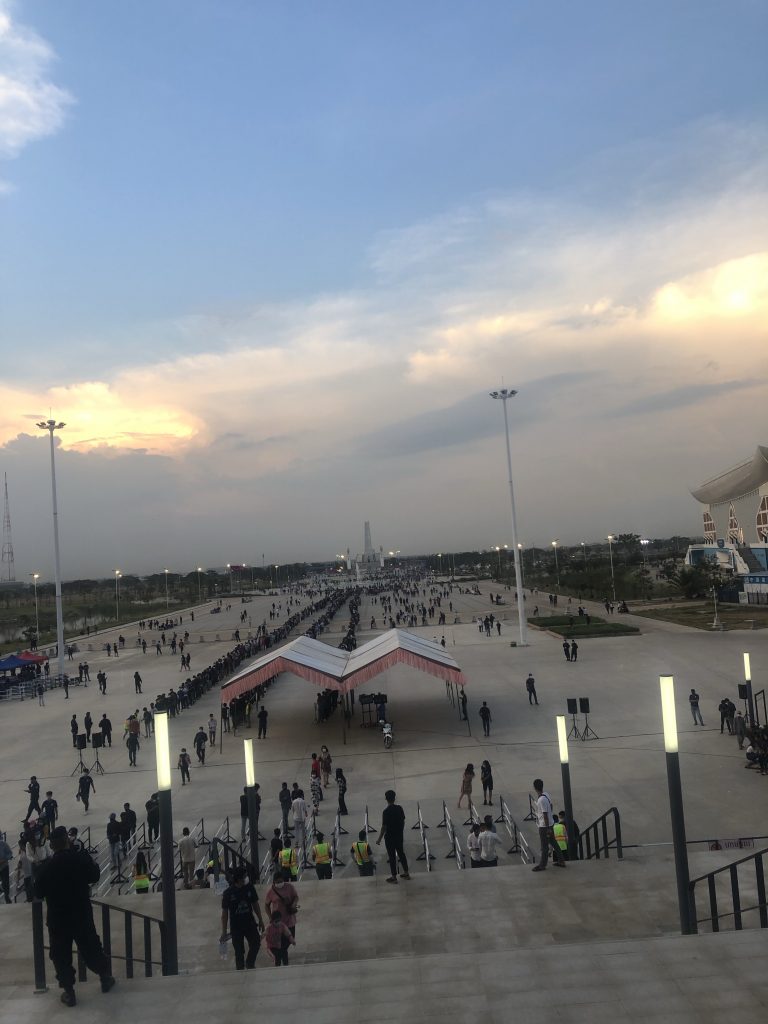If you live in Cambodia you will know there’s a monument to the win-win policy, as well as a national holiday to celebrate it, but what was the win-win policy and what is its legacy today?
Prelude the Cambodian Civil War

The Cambodian Civil War of the 1980’s was one of the strangest and perverse civil wars in history. The Khmer Rouge under Pol Pot had overseen one of the bloodiest and and delay regimes in history through the Democratic Kampuchea regime.
The abject brutality of the regime led to the Eastern Regions under the tutelage of now socialist Vietnam going to overthrow the Chinese supported, but communist Khmer Rouge.
A new, still communist regime, namely the People’s Republic of Kampuchea was established as part of the Soviet/Vietnamese sphere of influence and things ideally could and should have gotten back to some kind of normal, but alas these were not normal times.
The Cambodian Civil War of the 1980’s
Despite the Pol Pot clique having killed perhaps one third of the Khmer population they were anti-Soviet and therefore amazingly managed to not only retain western support, but also were recognised as the legitimate government of the country by the United Nations.
When one looks at recent wars that the west has condoned, we really should take a look at our legacy in South-East Asia.
To read if the Americans supported the Khmer Rouge click here
King Sihanouk, who had previously been in bed with the Khmer Rouge in its fight against the Khmer Republic again sided with Pol Pot and the country was again fighting against itself, with both Chinese, American and Thai support among others. The country was again menaced, filled with landmines and the people suffered as aid meant for Cambodia ended up going to areas controlled by the Khmer Rouge.
The State of Cambodia and the road to the Paris Peace Accords
In 1989 the country morphed itself into the State of Cambodia, references to Marxism-Leninism were dropped from the constitution and at last it seemed that there was a road to peace for everyone, including the Khmer Rouge.
By 1991 this lead to the perverse situation of the former war criminals of the Khmer Rouge not only being part of the peace process, but even being wined and dined as legitimate statesmen.
Despite having morphed from the Communist Party of Kampuchea into the Party of Democratic Kampuchea and finally the nationalist Cambodian National Unity Party the party decided to boycott the 1993 elections, again moving bad to their heartlands and creating the last Khmer Rouge state.
The slow road to the end of the Khmer Rouge and the win-win policy
The Khmer Rouge now largely operating from Anlong Veng declared the internationally unrecognized the Provisional Government of National Union and National Salvation of Cambodia (PGNUNSC).
To read about the last Khmer Rouge state click here.
Whilst running their own “government” from Anlong Veng the Khmer Rouge continued to fight against Cambodian forces, particularly those of the Cambodian People’s Party with alleged tactic support from the royalist FUNCINPEC.
Little known to the party centre Prime-Minister Hun Sen was sowing discord within their ranks, which led to a slew of defections initially started by Khieu Sampan closely followed by other leading members of the party.
Despite this the armed wing of the Khmer Rouge remained a formidable force and most importantly could have swayed the Cambodian Civil War of the late 90’s with whichever side they picked.
Pol Pot was eventually to die in 1998, with the Khmer rouge to be taken over by Ta Mok.
What was the Hun Sen Win-Win policy?
Quite simply it was the policy that if regiments, cadres and soldiers of the Khmer Rouge would defect to the government they would be considered Cambodian citizens, could keep their land, and most importantly even switch ro Royal Cambodian Army.
Initially many Khmer Rouge were extremely skeptical about the policy and for two very good reasons, firstly about whether the government would honour the policy, particularly with many having committed war crimes, but secondly through the Khmer Rouge itself.
Even towards the end of the regime the Khmer Rouge still created Killing Fields and would not hesitate in murdering anyone even suspected of potentially defecting to the enemy.
But the government of Hun Sen indeed kept their word and there were numerous ceremonies where National Army of Democratic Kampuchea soldiers would symbolically change their uniforms into those of the Royal Army of Cambodia. Word quickly spread and eventually cadres defected en-masse and by 1999 the war was basically over.
Was the win-win policy a success?
Quite whether the win-win policy is open to scholarly debate, but a few facts need to kept in mind. The Khmer Rouge remained firm fighting force until the late 90’s and had the win win policy not been implanted they would likely have continued fighting.
And while many Khmer Rouge win win winners were war criminals the vast majority had by that time been simple peasants largely conscripted into the rebel army.
From a practical point of view it has ushered in a new found era of prosperity and peace in the country, where while you might not always agree with the current strong man regime has at least mean a long period of peace.
In response stop controversies about the win-win policy of Cambodia?
Many parts of the policies towards the Khmer Rouge have become controversial, not just limited to the win-win policy. These have included the amnesties given to senior leaders in order to persuade them to defect and indeed the win-win policy itself for letting other potential war criminals go free.
The reality though is that Khmer Rouge were still being courted by western governments as late 1993 and were not even proscribed as an illegal organisation within Cambodia until 1996.
Secondly and perhaps more importantly and despite many being given amnesty the main leaders of the Communist Party of Kampuchea were eventually out on trial. Alas the western supporters of the regime were not and never will be.
Most modern controversy with regards to the policy tends to come from two forms, those either anti-CPP, or into Vietnamese, with the two often being the same people.
What about the Win-Win Memorial?
The Win-Win Memorial was one of the last Khmer Rouge based museums of monuments that I was to visit in Cambodia. The reason for this being that it is frankly in the middle of nowhere, although as fate would have it now directly opposite the $160 million Chinese built Morodok Techo Stadium.
To read about the stadiums of Cambodia click here.
The Win-Win Memorial (Khmer: វិមានឈ្នះឈ្នះ, Vĭméan Chhneăh Chhneăh was initially opened on 31 December 2018 by Prime Minister Hun Sen to mark the end of the civil war 20 years prior.
The monument is part of a huge 8 hectare plaza complete with eight pools, various sculptures, such as ones showing soldiers swapping their clothes. The monument cost approximately $12 million to build and is officially in the traditional Khmer style, although for those of us who have done our time in the old Eastern Bloc the similarities with Soviet and North Korean architecture cannot be ignored.
And at worst you can watch football and admire the Win-Win Monument from afar.





